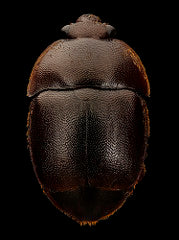Small Hive Beetles
BEEKEEPING SERIES: Integrated Pest Management
INTEGRATED PEST MANAGEMENT and SMALL HIVE BEETLES
Small Hive Beetles, who thrive in hot and humid areas, are not-surprisingly pervasive in Houston. The black, sunflower-seed-shaped beetles are normally found on inner-covers and on the outside frames of the hive. Some people see them on the bottom of the hive as well. If you live in Houston and don't have Small Hive Beetles (SHB), you will soon; they are a fact of life and part of the ecology of the hive. Learn more about Small Hive Beetles

LIFE CYCLE OF THE SMALL HIVE BEETLE
Adult Small Hive Beetles may live up to 6 months and have 4-5 generations a year during the warmer seasons.
Female beetles lay masses of eggs in cracks or crevices in a hive. In some cases, they even lay in the brood nest!
The eggs hatch in 2-3 days into white-colored larvae that will grow to 10-11 mm in length. Larvae feed on pollen and honey (and in severe cases pupae), damaging combs, and require about 10-16 days to mature.
Larvae that are ready to pupate, leave the hive (usually dropping through a bottom screen) and burrow into soil near the hive.
The pupation period lasts approximately 3-4 weeks. Newly emerged adults seek out hives and females generally mate and begin egg laying about a week after emergence. (source: Wikipedia & Bee Culture)
THE PROBLEM WITH SMALL HIVE BEETLES
The adults we normally see (and smash!) are not the issue.
It's the feeding activity of the larvae that is the problem.
Larvae tunnel through comb with stored honey or pollen, destroying it. Further, larvae defecate in honey and the honey becomes discolored from the feces.
Activity of the larvae causes fermentation and a frothiness in the honey; the honey develops a characteristic odor of decaying oranges. Popularly called "sliming the hive," damage and fermentation cause honey to run out of combs, creating a mess in hives or extracting rooms.
Heavy infestations cause bees to abscond; some beekeepers have reported the rapid collapse of even strong colonies. Sometimes the SHB infestation causes the bees to leave quickly, sometimes SHB take over once a hive has absconded for other reasons - it's often hard to tell on hives not well monitored. (source: Wikipedia)

IPM STRATEGY OF SMALL HIVE BEETLES
The #1 strategy against the little black beetles: a strong colony.
Bees are very good at controlling Small Hive Beetles. They are the ones that push them to the outside frames and to the inner cover. You've probably witnessed them chasing down and corralling a SHB. They'll even build little jails out of propolis (which the beekeeper will inadvertently open). But, it is a numbers game. SHB can take over if the colony is weak or small.
Various strategies against Small Hive Beetles:
- Maintaining a full, strong colony (duh)
- Not giving the bees too much space - if they are a small colony, consider a nuc hive - if they are *almost* ready for another super but are having queen issues or have been losing the SHB battle, perhaps wait to add the next box
- Sunshine - SHB hate light - the shadier the beehive, the more SHB you'll have. I have no preference for full sun or full shade hives, but know you'll might need more precaution with shady hives
- Screened Bottom Boards vs Solid - this is a debatable subject - some say the screen helps the larvae drop to the soil and return. I personally employ a screened bottom board with a West trap underneath
- Physical Traps - there are many physical things that can help bees trap SHB. Cut up "Beetle BeeGone" sheets (unscented Swiffer or Swiffer generic sheets work just as well), Beetle Blaster traps, Beetle Barns, Freeman Beetle Trap and West Trap - the list goes on and on
- Ground Drench - If you want to go the chemical route, you can apply a drench to the soil around the hive, but it can be harmful to crawling bees.
- Nothing at all - Beekeeper Dean Cook of the Houston Natural Beekeepers Association says that when he stopped trying to fight Small Hive Beetles he suddenly stopped losing hives to Small Hive Beetles
OUR EARLY EXPERIENCE WITH SMALL HIVE BEETLES
Bee2Bee did lose a hive to Small Hive Beetles in early summer of 2017. It was the result of a stalled nuc (the nuc came with supersedure cells); we received a new queen but the overall numbers of the workers remained low. I noticed that the female SHB were laying eggs in the inner frame feeder - if you see a lot of larvae in your feeders, you may want to switch to another method of feeding (or stop feeding altogether).
BEE2BEE STRATEGY: SMALL HIVE BEETLES
Depending on the hive and if SHB are present or not - a combination of Swiffer sheets, Beetle Blasters with food grade diatomaceous earth (DE), Beetle Barns with DE in top bar hives, and West traps with DE. In some cases - nothing at all.
We had previously employed vegetable oil in the traps - which was messy and turn rancid - then mineral oil in the traps - which was pricey and still messy - before switching to diatomaceous earth.
Yes, diatomaceous earth is harmful to honeybees as well, which is why one needs to be careful when putting it in the trap. Steve Brackmann, the president of the Houston Beekeepers Association told me he has switched to using garden lime in his beetle blasters.
